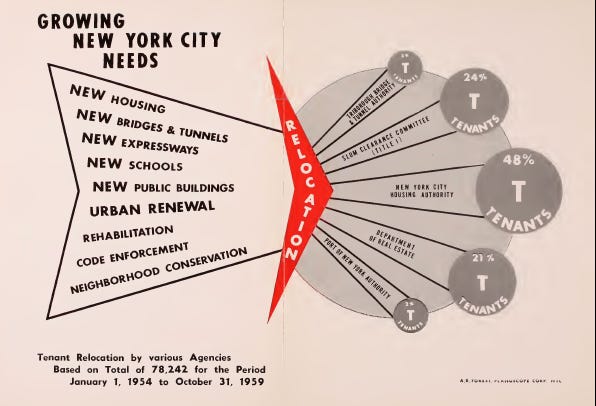We estimate that roughly 3 million Americans1 were displaced by federally-funded urban renewal and highway projects, 1950-1980.2 But because of the multiple laws and agencies involved, we haven’t (yet) been able come up with a more precise number.
The case of New York City in the 1950s illustrates this research challenge. Five separate agencies, each responsible for multiple infrastructure projects, displaced almost 80,000 families between 1954 and 1959. At the time, NYC had received more urban renewal funding than any other city, close to 12% of the national total. In addition to renewal projects, the City forced residents and businesses to move to make way for new roads, bridges, schools, post offices, and housing developments.

Each city agency had its own relocation procedures, shaped by relevant municipal, state, and federal laws. And each had its own system for tracking the movement of redevelopment-site residents. Adding to the complexity, Robert Moses’s Committee on Slum Clearance transferred responsibility for relocation to private sponsors, like Lincoln Center.
To get a sense of the scale of postwar displacement, multiply the admittedly outsized NYC example across hundreds of town, city, county, and state governments (each with its own housing, urban renewal, and transportation agencies). As a research task, it’s enormous. This is why we hope to connect with the scholars and local historians who are already digging into these records and to encourage others to start researching redevelopment in the places where they live.
Our very rough estimate is based on data from U.S. Department of Housing and Urban Development (HUD) ’s Statistical Yearbooks and calculations by Aaron Jette of the U.S. Department of Transportation’s Volpe Center. Per HUD’s 1971 Statistical Yearbook, about 1.3 million Americans [310,908 families x 3.58 (average family size per the 1970 Census) + 159,099 individuals] had been displaced from urban renewal sites as of 6/30/71. This figure doesn't include people who would later be displaced for UR projects in planning or early stages of implementation. The 1972 Statistical Yearbook appears to report an additional 171,296 families and 108,758 individuals displaced or awaiting relocation. Later editions of the Statistical Yearbook do not include relocation data. We estimate that roughly 1.5 million Americans were displaced by urban renewal projects, 1950-1980. Aaron Jette of the U.S. Department of Transportation’s Volpe Center, estimates that an additional 1-1.5 million were displaced by highways, 1956-1976.
This figure does not include displacements for public housing outside of urban renewal areas. Nor does it include the people displaced for dams, non-highway transportation projects, etc.


